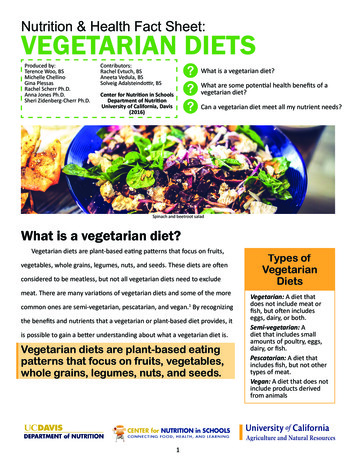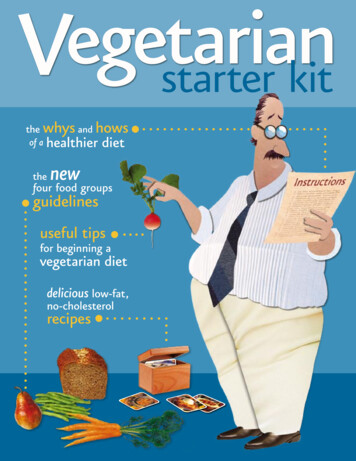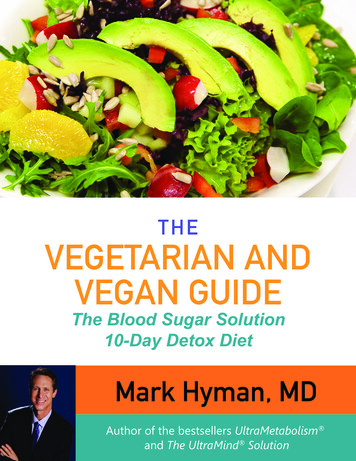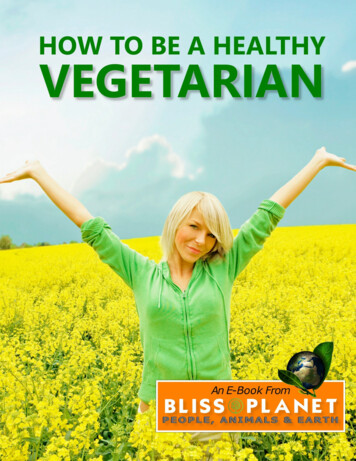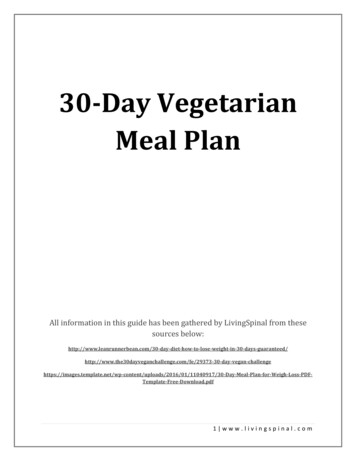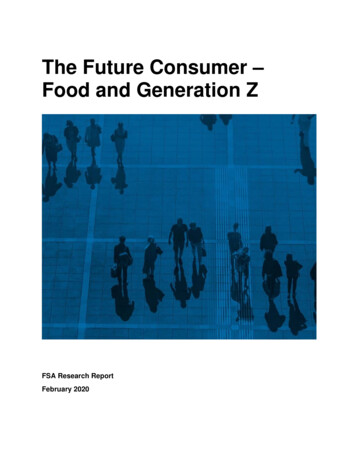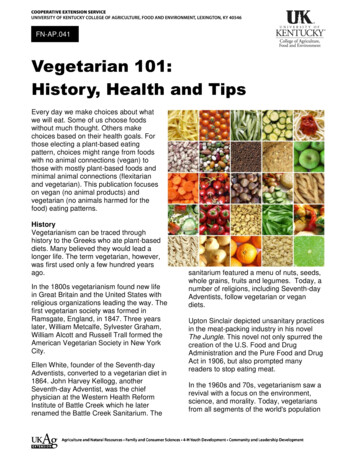
Transcription
FN-AP.041Vegetarian 101:History, Health and TipsEvery day we make choices about whatwe will eat. Some of us choose foodswithout much thought. Others makechoices based on their health goals. Forthose electing a plant-based eatingpattern, choices might range from foodswith no animal connections (vegan) tothose with mostly plant-based foods andminimal animal connections (flexitarianand vegetarian). This publication focuseson vegan (no animal products) andvegetarian (no animals harmed for thefood) eating patterns.HistoryVegetarianism can be traced throughhistory to the Greeks who ate plant-baseddiets. Many believed they would lead alonger life. The term vegetarian, however,was first used only a few hundred yearsago.In the 1800s vegetarianism found new lifein Great Britain and the United States withreligious organizations leading the way. Thefirst vegetarian society was formed inRamsgate, England, in 1847. Three yearslater, William Metcalfe, Sylvester Graham,William Alcott and Russell Trall formed theAmerican Vegetarian Society in New YorkCity.Ellen White, founder of the Seventh-dayAdventists, converted to a vegetarian diet in1864. John Harvey Kellogg, anotherSeventh-day Adventist, was the chiefphysician at the Western Health ReformInstitute of Battle Creek which he laterrenamed the Battle Creek Sanitarium. Thesanitarium featured a menu of nuts, seeds,whole grains, fruits and legumes. Today, anumber of religions, including Seventh-dayAdventists, follow vegetarian or vegandiets.Upton Sinclair depicted unsanitary practicesin the meat-packing industry in his novelThe Jungle. This novel not only spurred thecreation of the U.S. Food and DrugAdministration and the Pure Food and DrugAct in 1906, but also prompted manyreaders to stop eating meat.In the 1960s and 70s, vegetarianism saw arevival with a focus on the environment,science, and morality. Today, vegetariansfrom all segments of the world's population
can be found following their dietary beliefsfor many reasons. It is estimated that about5 percent of those living in the UnitedStates consider themselves vegetarianswhile fewer than 3 percent are vegans.DefinitionsThe term vegetarian can be difficultto define. As a general guide,vegetarians eat a plant-based dietthat includes foods such as milk andeggs — foods made by animals butthat do not involve harming theanimal.Reasons for a Vegetarian or VeganLifestyleWe choose what to eat for many reasons,including taste, availability, what we grewup eating and how much money we have tospend on food. Ethics, personal health andenvironmental concerns are named mostfrequently as reasons for choosing avegetarian or vegan lifestyle. Other reasonsmay include financial and religious.Vegetarians enjoy a plant-based dietthat does not include the flesh of anyanimal. Vegetarians generally eatfoods produced by animals includinghoney, milk and eggs.No matter the reason there are somebenefits and challenges to following avegetarian or vegan diet. The morerestrictive the diet, the more challenges andpotential nutritional concerns and individualwill face.Vegans abstain from eating animalderived products including meats,dairy items, honey and eggs. Mostalso will not use any animal productsincluding leather, wool and silk.Lacto-ovo vegetarians enjoy aplant-based diet that includes dairyproducts and eggs.Health BenefitsUsually, vegetarian diets are lower in fat,saturated fat and cholesterol. Colorfulfruits and vegetables are nutritious. Drybeans are high in protein and fiber. Any dietcan be unhealthy if poor food choices aremade.Lacto vegetarians consume dairyproducts but no eggs.Ovo vegetarians enjoy eggs but nodairy products.Vegetarians might see the following healthbenefits: Lower death rates from coronaryheart disease. Lower LDL (bad) cholesterol andhigher levels of HDL (good)cholesterol. Lower average blood pressure. Lower incidence of type 2 diabetes. Lower death rates from colon cancer. Less constipation and diverticulardisease.There are other definitionsassociated with vegetarianism thatinclude more and less restrictiveeating patterns. These include“pescatarian” (those who eat fish andseafood), “pollotarian” (those who donot eat red meat) and “flexitarian” or“semi-vegetarian” (those who usuallyeat a plant-based diet but who alsoinclude lean meats, poultry andseafood on occasion).2
Possible Nutrient ChallengesAll humans need carbohydrates, protein,fats, vitamins, minerals and water to surviveand thrive. These nutrients come from thefoods we eat.and dried fruits.Protein may or may not be a concern forvegetarians. Generally, most Americansconsume adequate protein. It is needed forcell repair, growth and overall health.Protein is found in eggs and dairy products.Other sources include dry beans, nuts andtofu.Some needed nutrients are more readilyavailable in foods from animals. However,vegetarians, especially vegans who areaware of possible nutrient challenges, mayfind foods and ways to maintain their healthwith a diet featuring the right combination offoods. Vegetarians, and especially vegans,should be aware of their intake of severalkey nutrients, including vitamin B12,calcium, iron, protein, zinc and omega-3fats.Vitamin D helps move calcium into thebones. It is commonly added to milk. Thosewho do not consume milk may look to nondairy beverages fortified with vitamin D.Vitamin D also may be made by the bodywith adequate exposure to sunlight.Zinc is a mineral important for insulinactivity, growth, wound healing and ourability to taste. It is readily found in meats,especially red meats. Vegetarians maychoose wheat germ, eggs, zinc-fortifiedcereals, beans, lentils, nuts, whole-graincereals, dairy products and yeast for theirsource of zinc.Vitamin B12 is needed for the formation ofred blood cells, healthy brain function and ahealthy nervous system. It comes mainlyfrom animal-derived foods including eggsand dairy products. Those who do not eateggs or dairy may obtain vitamin B12 fromfortified cereals, nutritional yeast, soy milkand some soy products.Calcium is used in the body formuscle contraction and strongbones. Calcium is readily availablein many dairy products and manymilk substitutes. It also is found inleafy greens, including collards andkale. Other good food sourcesinclude calcium-fortified 100percent fruit juices and tofu madewith calcium sulfate.Iron carries oxygen in our bloodand plays a role in resistance toinfections. We easily absorb ironfrom animal sources. Vegetarians,specifically vegans and other strictvegetarians, may obtain iron fromfortified cereals, beans, spinach,chard, blackstrap molasses, bulgur3
Omega-3 fatty acids are essential nutrientsthat our bodies cannot make. They arerequired for heart and brain health.Vegetarians are especially challenged toget adequate amounts of omega-3 fats thatare easily used by the body. Fatty fishprovide DHA — the type ofomega-3 fatty acids most readily used bythe body. Plants provide ALA omega-3s, atype that must be converted by the body toa more usable form. It is difficult for thebody to convert ALA omega-3s. Goodsources of ALA omega-3 fats are chiaseeds, pumpkin seeds, flax seeds,soybeans and walnuts. Vegetariansupplements of omega-3 fats are availableand may be a topic to discuss with yourhealthcare provider.sodium. Better choices are those thatcontain no more than 350 mg sodium perserving. Some meat substitutes are high insaturated fat. Saturated fat is known tocontribute to heart disease. Look forproducts with no more than 10 % DV (dailyvalue) of saturated fat per serving. Also,look to see whether the meat substitute hasadded vitamins and minerals, such as zincand vitamin B12 — the ones most oftenlacking in the vegetarian or vegan diet.Enjoyable food textures are a personalpreference. Different brands of similarproducts of meat substitutes may havedifferent flavors and textures. Be sure tofollow the cooking instructions provided withthe product. Undercooking may lead tofoodborne illness while overcooking mayresult in something dry, tough, chewy andinedible.Fake Meats“Fake meats” or meat substitutes areavailable in many grocery stores. Many aremade to look like the meat or product theyare substituting. Products include tofu dogs,tofu turkey, soy bacon, and vegetariancrumbles. Many meat substitutes are madewith tofu, or textured vegetable or soyprotein (TVP or TSP). Read the nutritionlabel to ensure the products provide thedesired nutrition. Many products are high inEating Vegetarian and Vegan Away fromHomeFollowing an eating plan at home, wherefood purchasing and preparation readily arecontrolled, makes being a vegetarian orvegan easier. When away from home, theremay be challenges.If dining at someone's homeit is best to let your hostknow your dietaryrestrictions well ahead oftime. Always offer to bring adish to add to the meal tohelp relieve stress on thehost or hostess. Whendining at a restaurant, doresearch ahead of time.Don't be afraid to askquestions about preparationmethods or techniques.Some restaurants willaccommodate reasonablerequests.4
Moving Toward a Plant-Based DietThose who wish to move toward a plantbased diet may be overwhelmed with theidea. In reality, it may not be that difficult.Determine your goals and why you want toadopt a vegetarian or vegan lifestyle. Youmight start with eating one vegetarian orvegan meal a week. Consider the foods youcurrently enjoy that have no meat or meatproducts in them. Hummus, macaroni andcheese, pesto sauce and other foods mayalready be in your eating plan and may bevegetarian or vegan.Simple changes may often be made tofavorite recipes to make them vegetarian orvegan. Instead of choosing beef or chickenbroth for your vegetable soup, choosevegetable broth or tomato juice. Select fatfree or vegetarian refried beans. Useseasoned black or pinto beans instead ofchicken or beef. Spice up red beans andrice instead ofchoosing meatladen jambalaya.Add nuts andseeds to yourfavorite salad toadd protein andcrunch.SummaryThere are benefits and challenges for thosechoosing to follow a plant-based vegetariandiet. Awareness, research, experimentationand knowledge of your goals and reasonswill help guide your food choices. Makingsmall changes over time can help you movetoward a more plant-based diet.ResourcesAvey, T. (28 January 2014). From Pythagorean to Pescatarian – The Evolution ofVegetarianism. The History Kitchen retrieved February 19, 2015 at etarianism/.Gustafson, N. (April 2007). Vegetarian Nutrition, Ashland, OR: Nutrition Dimension.Hunt, JR. (September 2003). Bioavailability of iron, zinc, and other trace minerals fromvegetarian diets. Am J Clin Nutr. Vol. 78 no. 3 633S-639S. Retrieved February 19, 2015 ng.McBride, J. (March 1998). Vegetarians, Watch Your Zinc. Agriculture Research. RetrievedFebruary 19, 2015 from 98.pdf.Melina, V. & Davis, B. (2003). The New Becoming Vegetarian. Summertown, TN: HealthyLiving Publications.Moore, M. (July/August 2013). Counseling a Conscious Choice. Food & Nutrition. 12-13.The Vegetarian Resource Group at http://www.vrg.org/.Vannice, GK. (2011). Omega-3 Handbook: A Ready Reference Guide for HealthProfessionals. Portland, OR: Omega-3 RD .5
Vegetarian Diets: Build on the Basics (Revised May 2008). Arizona Cooperative Extension,AZ1231. Retrieved February 19, 2015 rizona.edu/files/pubs/az1231.pdf.Vegetarianism in a Nutshell (n.d.). The Vegetarian Resource Group. Retrieved February 19,2015 from nism in a Nutshell (n.d.). The Vegetarian Resource Group. Retrieved February 19, 2015from http://www.vrg.org/nutshell/vegan.htm.Vitamin B12 Information Sheet (n.d.). Vegetarian Society. Retrieved February 19, 2015 fromhttps://www.vegsoc.org/B12.Photos: 123RF.comUniversity of Kentucky College of Agriculture, Food and EnvironmentFamily and Consumer Sciences ExtensionDiane M. Mason, M.S., R.D., L.D.Boone County Extension Agent for Family and Consumer SciencesJanet T. Mullins, Ph.D., R.D., L.D.Extension Specialist for Food and NutritionApril 2016Copyright 2016 for materials developed by University of Kentucky Cooperative Extension. This publication maybe reproduced in portions or its entirety for educational or nonprofit purposes only. Permitted users shall givecredit to the author(s) and include this copyright notice.Educational programs of the Kentucky Cooperative Extension serve all people regardless of race, color, age, sex,religion, disability, or national origin.6
vegan meal a week. Consider the foods you currently enjoy that have no meat or meat products in them. Hummus, macaroni and cheese, pesto sauce and other foods may already be in your eating plan and may be vegetarian or vegan. Simple changes may often be made to favorite recipes to make them vegetarian or
